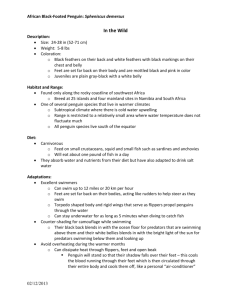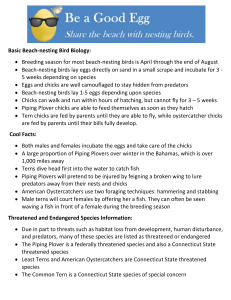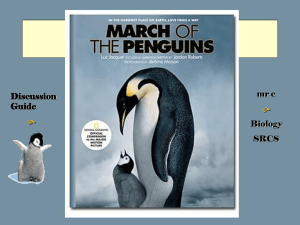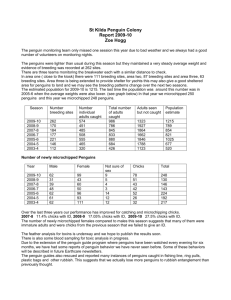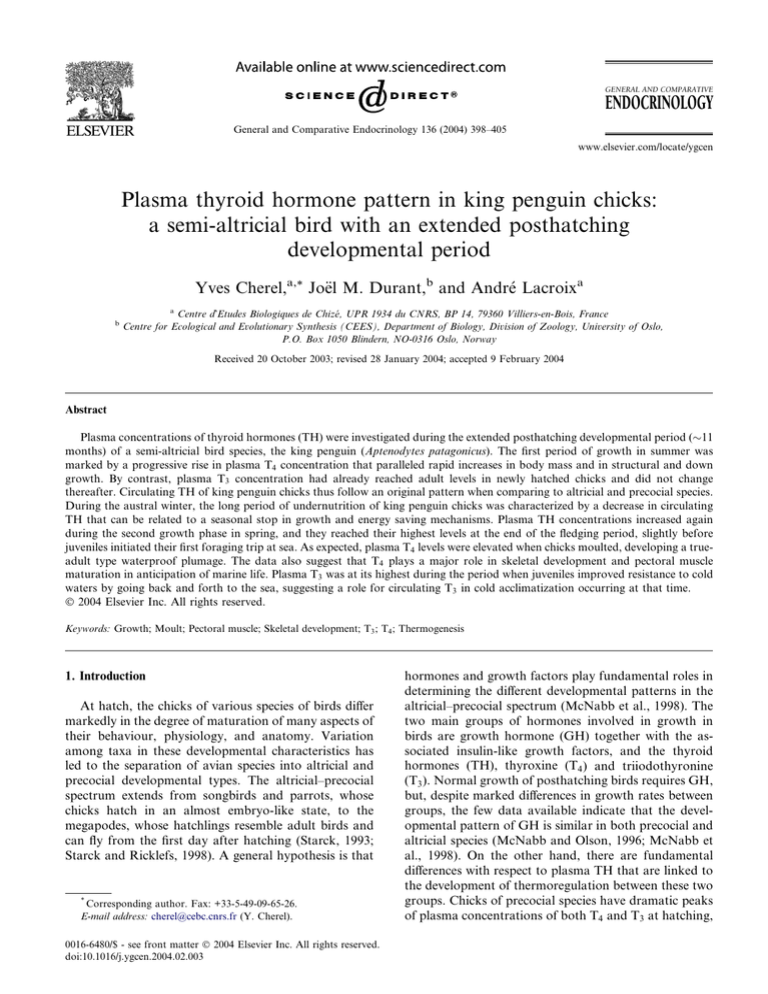
GENERAL AND COMPARATIVE
ENDOCRINOLOGY
General and Comparative Endocrinology 136 (2004) 398–405
www.elsevier.com/locate/ygcen
Plasma thyroid hormone pattern in king penguin chicks:
a semi-altricial bird with an extended posthatching
developmental period
Yves Cherel,a,* Jo€el M. Durant,b and Andre Lacroixa
b
a
Centre dÕEtudes Biologiques de Chize, UPR 1934 du CNRS, BP 14, 79360 Villiers-en-Bois, France
Centre for Ecological and Evolutionary Synthesis (CEES), Department of Biology, Division of Zoology, University of Oslo,
P.O. Box 1050 Blindern, NO-0316 Oslo, Norway
Received 20 October 2003; revised 28 January 2004; accepted 9 February 2004
Abstract
Plasma concentrations of thyroid hormones (TH) were investigated during the extended posthatching developmental period (11
months) of a semi-altricial bird species, the king penguin (Aptenodytes patagonicus). The first period of growth in summer was
marked by a progressive rise in plasma T4 concentration that paralleled rapid increases in body mass and in structural and down
growth. By contrast, plasma T3 concentration had already reached adult levels in newly hatched chicks and did not change
thereafter. Circulating TH of king penguin chicks thus follow an original pattern when comparing to altricial and precocial species.
During the austral winter, the long period of undernutrition of king penguin chicks was characterized by a decrease in circulating
TH that can be related to a seasonal stop in growth and energy saving mechanisms. Plasma TH concentrations increased again
during the second growth phase in spring, and they reached their highest levels at the end of the fledging period, slightly before
juveniles initiated their first foraging trip at sea. As expected, plasma T4 levels were elevated when chicks moulted, developing a trueadult type waterproof plumage. The data also suggest that T4 plays a major role in skeletal development and pectoral muscle
maturation in anticipation of marine life. Plasma T3 was at its highest during the period when juveniles improved resistance to cold
waters by going back and forth to the sea, suggesting a role for circulating T3 in cold acclimatization occurring at that time.
Ó 2004 Elsevier Inc. All rights reserved.
Keywords: Growth; Moult; Pectoral muscle; Skeletal development; T3 ; T4 ; Thermogenesis
1. Introduction
At hatch, the chicks of various species of birds differ
markedly in the degree of maturation of many aspects of
their behaviour, physiology, and anatomy. Variation
among taxa in these developmental characteristics has
led to the separation of avian species into altricial and
precocial developmental types. The altricial–precocial
spectrum extends from songbirds and parrots, whose
chicks hatch in an almost embryo-like state, to the
megapodes, whose hatchlings resemble adult birds and
can fly from the first day after hatching (Starck, 1993;
Starck and Ricklefs, 1998). A general hypothesis is that
*
Corresponding author. Fax: +33-5-49-09-65-26.
E-mail address: cherel@cebc.cnrs.fr (Y. Cherel).
0016-6480/$ - see front matter Ó 2004 Elsevier Inc. All rights reserved.
doi:10.1016/j.ygcen.2004.02.003
hormones and growth factors play fundamental roles in
determining the different developmental patterns in the
altricial–precocial spectrum (McNabb et al., 1998). The
two main groups of hormones involved in growth in
birds are growth hormone (GH) together with the associated insulin-like growth factors, and the thyroid
hormones (TH), thyroxine (T4 ) and triiodothyronine
(T3 ). Normal growth of posthatching birds requires GH,
but, despite marked differences in growth rates between
groups, the few data available indicate that the developmental pattern of GH is similar in both precocial and
altricial species (McNabb and Olson, 1996; McNabb et
al., 1998). On the other hand, there are fundamental
differences with respect to plasma TH that are linked to
the development of thermoregulation between these two
groups. Chicks of precocial species have dramatic peaks
of plasma concentrations of both T4 and T3 at hatching,
Y. Cherel et al. / General and Comparative Endocrinology 136 (2004) 398–405
which is marked by the initiation of thermoregulation.
By contrast, plasma TH concentrations do not peak and
are very low at hatching in altricial species. They then
progressively increase to approach adult values by the
time of the greatest endothermic improvements during
nestling life (McNabb and Olson, 1996; McNabb et al.,
1998; Olson et al., 1999).
Hormonal control of avian growth has been nearly
exclusively studied in poultry species, which have the
precocial pattern of development. Consequently, an issue
that needs to be addressed is whether the endocrine
changes observed to date are truly representative of
precocial and altricial patterns or simply species-specific
differences (McNabb et al., 1998). More work on wild
birds, including species from several orders, are therefore
needed to confirm our current views of hormonal control
of developmental differences, including the poorly
investigated semi-altricial and semi-precocial types.
Semi-altricial neonates, including penguins (order
Sphenisciformes), have open eyes and are relatively active soon after hatching when comparing to truly altricial
chicks (Starck, 1993; Starck and Ricklefs, 1998). Newly
hatched penguins have only a thin covering of downy
feathers, they remain in the nest, and are entirely dependent on their parents for food for several weeks to
months. In addition, penguin chicks are unable to regulate their own body temperature at birth and they are
therefore brooded by their parents for between 2 and 6
weeks, depending on the species. Afterwards, chicks are
left alone and group together during the so-called creche
period, both parents foraging at sea and returning at
intervals to feed their offspring. Finally, large chicks
moult, developing true-adult type waterproof feathers,
before going at sea to feed by themselves for the first time
(Williams, 1995). At the end of the chick-rearing period,
the terrestrial chicks thus face an intensive and prolonged energetic demand during their passage from shore
to marine life in cold waters (Barre and Roussel, 1986).
King penguins (Aptenodytes patagonicus) have a unique reproductive cycle among birds, since an entire
cycle including moult lasts 14–15 months. The main
striking feature is an extended chick-rearing period,
which can be divided into three parts: a first period of
growth in summer and early fall, a prolonged period of
undernutrition in late fall and winter, and a second period of growth that precedes moult in spring. The whole
chick-rearing period therefore lasts about 11 months
between hatching in January and departure to sea in
December (Barrat, 1976; Stonehouse, 1960). The aim of
the present work was to describe TH pattern during the
unusual posthatch development of king penguins. Emphasis was made on the first growth period to compare
TH pattern of a semi-altricial bird with that of altricial
and precocial species. Time-correlations between TH
and both moult and the departure to sea of king penguin
chicks in spring were also investigated, because TH are
399
required for moult (Groscolas and Cherel, 1992; Kuenzel, 2003) and they are involved in the control of
thermogenic processes in birds (McNabb and Olson,
1996; Silva, 1995).
Finally, since food limitation is associated with decreasing plasma TH concentrations in avian species (Le
Ninan et al., 1988; Sharp and Klandorf, 1985), we investigated time-correlations between chicksÕ body condition and circulating TH concentrations, focusing on
the winter fast and on the period preceding departure to
sea in spring. Nutritional status of the chicks was assessed
through the determination of plasma b-hydroxybutyrate
(a ketone body) and uric acid (the main nitrogen excretory product in birds), which are good indices of lipid and
protein utilization, respectively. Plasma b-hydroxybutyrate is low and uric acid high in fed king penguins (Cherel
and Le Maho, 1988; Le Ninan et al., 1988). Conversely,
plasma b-hydroxybutyrate is high and uric acid low in
fasting birds, which preferentially use their lipid reserves
while sparing their endogenous body proteins (Cherel
and Le Maho, 1985; Cherel et al., 1988c).
2. Materials and methods
Fieldwork was carried out on the ^Ile de la Possession,
Crozet Archipelago (46°250 S; 51°450 E) during the 1992
breeding cycle in the colony of La Baie du Marin (40,000
pairs) (Weimerskirch et al., 1992). The egg-laying period
of king penguin span 4 months, but only pairs that lay at
the beginning of this period are successful (Olsson,
1996). Consequently, chicks of that study are early
chicks, i.e., those hatching in January/February. Blood
was sampled on breeding adult birds in fall and at 12
different developmental stages according to the chronology of the cycle, i.e., chick growth, acquisition of
homeothermy, moult, and departure to sea (Table 1).
Ten king penguins were randomly chosen for each
group. Birds were sampled once. Each bird was weighed,
and the length (accuracy 1 mm) of beak, foot, and
flipper was measured according to Stonehouse (1960).
Blood samples (usually 5 ml) were taken from a flipper
vein (cardiac puncture for hatchlings and 2 weeks old
chicks) with heparinized syringes. Blood samples were
kept in the field at +5 °C in crushed ice during 1–2 h
before being partitioned and centrifuged in the laboratory. Plasma from one microtube was deproteinized in
7% perchloric acid, and the supernatant solution neutralized with 10% KOH. Whole plasma and deproteinized plasma were frozen and kept at )20 °C until
assayed. Deproteinized plasma was used for the enzymatic determination of b-hydroxybutyrate (Williamson
and Mellanby, 1974) and whole plasma for the determination of uric acid (Scheibe et al., 1974).
Total plasma TH was determined by radioimmunoassays on whole plasma without extraction and
400
Y. Cherel et al. / General and Comparative Endocrinology 136 (2004) 398–405
Table 1
Blood sampling schedule in relation to age, development and growth, and moult stages in king penguins (following Barrat, 1976; Barre, 1978; Cherel
et al., 1987; Duchamp et al., 2002; Stonehouse, 1960; Weimerskirch et al., 1992)
Season
Months
Age
Abbreviations
Developmental stages
Plumage and moult stages
End of January
Mid-February
0 week
2 weeks
0
2
Almost unfeathered
Chick down growth
End of February
4 weeks
4
March
7 weeks
7
Fall
April
2.5 months
B
Winter
June–July
Early September
Late October
5 months
7.5 months
9 months
M
E
Sp
Hatching
Progressive acquisition of
homeothermy
Emancipation, end of
brooding phase
Middle of the first
growth period
End of first growth period
and beginning of winter fast:
first peak body mass
Middle of winter fast
End of winter fast
Second peak body mass
Mid-November
9.5 months
B
Beginning of moult
Late-November
10 months
M
Mid-Moult
Early December
10.5 months
E
End of Moult
Mid-December
11 months
Sea
Departure to sea
Mid-March
>4 years
Adults
Parents returning ashore
to feed their offspring
(control birds)
Chicks
Summer
Spring
Adults
Summer
following the procedure detailed in Chastel et al. (2003).
Pooled plasma of different king penguins produced a
dose–response curve that paralleled the TH standard
curves. These radioimmunoassays were different from
those previously used in king penguins (Cherel et al.,
1988a,c; Le Ninan et al., 1988). However, the two sets of
assays gave similar results for different animals in identical nutritional conditions—fed king penguin chicks at
the beginning of the winter fast. The values obtained in Le
Ninan et al. (1988) and in the present work were 8.4 3.3
(n ¼ 9) and 9.7 2.1 nmol/L (n ¼ 10), and 1.2 0.9 and
1.0 0.4 nmol/L for T4 and T3 , respectively.
Values are means SD. Data were statistically analysed using SYSTAT 9 for WINDOWS (Wilkinson,
1999). Means for each parameter at each developmental
stage were compared using a Kruskal–Wallis one-way
analysis of variance and Mann–Whitney U tests were
used for comparisons between two groups.
3. Results
3.1. Growth: body mass and structural size
Overall, body mass changed significantly over the
chick-rearing period (Kruskal–Wallis; H12;130 ¼ 123,
Chick down growth
End of chick down growth
Chick down
Chick down
Chick down
Chick down, synthesis
of new tail feathers
Chick down, end of synthesis
of tail feathers, beginning of
synthesis of body feathers
Loss of chick down, synthesis
of body feathers
End of chick down loss,
body feathers fully grown
Feathers ( ¼ true-adult type
waterproof feathers)
Feathers
p < 0:0001). It rose from 0.30 0.02 kg at hatching to
6.1 0.2 kg at 7 weeks (Mann–Whitney; U ¼ 0,
p < 0:0001), and to 10.8 0.4 kg (U ¼ 0, p < 0:0001) at
the end of the first growth phase, 2.5 months later
(Fig. 1). It then dropped by 44%, to 6.0 0.3 kg
(U ¼ 100, p < 0:0001), at the end of the long winter fast.
The second growth phase in spring was marked by an
increase in body mass to 13.0 1.5 kg (U ¼ 0,
p < 0:0001), which decreased during moult and until the
departure to sea to 8.6 0.6 kg (U ¼ 0, p < 0:0001).
Adult birds rearing chicks in autumn weighed
13.9 1.0 kg (Fig. 1).
Beak, feet, and flippers increased in size during the
chick-rearing period (H12;130 ¼ 119, 83, and 102, respectively, all p < 0:0001). Growth of beak, feet, and
flippers was most rapid during the first months of life
(Fig. 2) (all U ¼ 0 and p < 0:001, when comparing
chicks at hatching and at the beginning of the winter
fast). By the end of the first growth phase, feet had
reached full adult size (U ¼ 53:5, p ¼ 0:790), while
flippers continued to growth, but at a slower rate, to
reach the adult length at the end of the fledging period
(U ¼ 89:5 and 43, p ¼ 0:003 and 0.596, when comparing chicks at the beginning of winter and at their
departure to sea, and the latter group with adults,
respectively). Beak stopped growing during winter
Y. Cherel et al. / General and Comparative Endocrinology 136 (2004) 398–405
401
Fig. 1. Body mass measurements of growing king penguin chicks at
various developmental stages. Values are means SD. Abbreviations:
B, beginning; M, middle; E, end; and Sp, Spring. Hatched bars represent winter fast and spring moult.
(U ¼ 30, p ¼ 0:130) but its length increased again in
spring (U ¼ 7, p ¼ 0:001 when comparing chicks at
the end of winter and at the beginning of moult).
Beak of birds departing to sea is, however, smaller
than that of adults (U ¼ 5, p ¼ 0:001), indicating that
beak growth continues after departure to sea. At
fledging the length of beak, feet, and flippers had
reached 87.5, 98.9, and 99.6% of the adult size, respectively (Fig. 2).
3.2. Nutritional status: plasma b-hydroxybutyrate and
uric acid
Plasma metabolite concentrations changed significantly amongst developmental stages (H12;131 ¼ 81 and
H12;129 ¼ 67, both p < 0:0001 for b-hydroxybutyrate
and uric acid, respectively). Plasma b-hydroxybutyrate
remained at moderate values (0.42–0.81 mmol/L) during the first period of chick growth, as it was in adult
birds (Fig. 3). It rose to 1.41 0.92 mmol/L during
the winter fast (U ¼ 7:5, p < 0:0001), and then decreased to 0.59 0.14 mmol/L during the second
growth period in spring (U ¼ 111, p ¼ 0:004). Plasma
b-hydroxybutyrate increased progressively thereafter
and reached its highest concentration in birds departing to the sea (2.22 0.85 mmol/L; U ¼ 90,
p < 0:0001).
Plasma uric acid concentration was moderate (0.47–
0.68 mmol/L) in chicks during the first period of growth
and in adult birds (Fig. 3). It then dropped to low values
during the winter fast (0.21 0.20 mmol/L; U ¼ 95,
p ¼ 0:005). The second growth phase was marked by
high concentrations that peaked at that time
(0.96 0.24 mmol/L; U ¼ 2, p < 0:0001, when compar-
Fig. 2. Structural size in growing king penguins chicks. Beak, foot, and
flipper measurements at various developmental stages. Values are
means SD. Abbreviations: B, beginning; M, middle; E, end; and Sp,
Spring. Hatched bars represent winter fast and spring moult.
ing chicks in the middle of winter and in spring). Plasma
uric acid thereafter decreased progressively and reached
its lowest values at the end of moult and in birds departing to sea (0.15–0.16 mmol/L; U ¼ 90 and 0, respectively, both p < 0:0001).
3.3. Thyroid hormones: plasma T4 and T3
Plasma TH concentrations and the ratio T3 =T4
changed significantly amongst developmental stages
(H12;133 ¼ 108, 63, and 90 for T4 , T3 , and T3 =T4 ,
402
Y. Cherel et al. / General and Comparative Endocrinology 136 (2004) 398–405
Fig. 3. Nutritional status during growth of king penguin chicks.
Plasma concentrations of b-hydroxybutyrate and uric acid at various
developmental stages. Values are means SD. Abbreviations: B, beginning; M, middle; E, end; and Sp, Spring. Hatched bars represent
winter fast and spring moult.
respectively, all p < 0:0001). Plasma T4 was very low
at hatching (1.7 1.2 nmol/L) (Fig. 4). It then increased during the first weeks of life, peaking in the
middle of the first growth period (15.9 5.6 nmol/L;
U ¼ 0, p < 0:0001), during which it reached adult
values (13.8 8.4 nmol/L; U ¼ 64, p ¼ 0:290). Concentrations dropped thereafter to low values during
the winter fast (5.3 2.7 nmol/L; U ¼ 97, p < 0:0001).
They increased again during the second growth period and moult (U ¼ 2 and 0 when comparing chicks
at the end of winter with those in spring and at the
end of moult, respectively, both p < 0:0001), and
reached their highest values at the end of moult and
before juveniles initiated foraging at sea (40.0–
47.3 mmol/L).
Plasma T3 concentration had already reached adult
values at hatching (1.24 0.43 and 1.04 0.53 nmol/L for
hatchlings and adult king penguins, respectively; U ¼ 71,
p ¼ 0:112) (Fig. 4). It did not change during the first period of chick growth, but it decreased to low values at the
end of the winter fast (0.33 0.23 nmol/L, U ¼ 95,
p < 0:0001 when comparing chicks at the beginning and
the end of winter). Plasma T3 then increased progressively
during the whole spring, reaching its highest concentra-
Fig. 4. Plasma concentrations of thyroid hormones (thyroxine and
triiodothyronine) and their molar ratio in growing king penguin chicks
at various developmental stages. Values are means SD. Abbreviations: B, beginning; M, middle; E, end; and Sp, Spring. Hatched bars
represent winter fast and spring moult.
tion before chicks departed to sea in December
(2.03 0.67 nmol/L; U ¼ 100, p < 0:0001).
The molar ratio T3 =T4 was elevated at hatching and it
was nine times higher than in adult plasma (1.09 0.73
and 0.12 0.08, respectively; U ¼ 90, p < 0:0001). It
then decreased during the first period of chick growth
(U ¼ 90, p < 0:0001 when comparing chicks at hatching
and at the beginning of winter) and remained at these
low values during the winter fast (0.10–0.26). In spring,
there was a further initial decline of the ratio to very low
values (<0.10; U ¼ 82, p ¼ 0:015 when comparing
chicks at the end of winter and in spring), which stabilized thereafter (Fig. 4).
Y. Cherel et al. / General and Comparative Endocrinology 136 (2004) 398–405
4. Discussion
4.1. The first growth phase of king penguin: thyroid
hormone pattern in a semi-precocial bird
To our knowledge, this work is the first to investigate
the developmental TH pattern of a semi-altricial bird. In
the few altricial species so far investigated, both plasma
T4 and T3 concentrations are very low at hatching and
increase steadily thereafter (McNabb and Olson, 1996;
McNabb et al., 1998). In king penguin chicks, plasma T4
followed this general pattern (with a different time scale,
here in weeks, not in days, due to the long developmental period of this large species), rising from hatching
to the middle of the first growth period (7 weeks). In
contrast with that pattern, plasma T3 had already
reached adult values at hatching and did not change
during the first growth phase. This also contrasts with
the peak in TH at hatching observed in precocial birds
(McNabb and Olson, 1996; McNabb et al., 1998).
Hence, circulating TH of king penguin chicks follow an
original pattern, thus highlighting the need for more
information on hormonal changes in species belonging
to different orders and families and with different patterns of development.
A consequence of low T4 and high T3 plasma concentrations at hatching is that the molar ratio T3 =T4 was
extremely high at that time, ninefold higher than in
adult plasma. Such values have been rarely encountered
in birds, in which T4 concentrations normally exceed
those of T3 in plasma by severalfold (T4 : 6–19 nmol/L,
T3 : 0.7–1.5 nmol/L; McNabb, 2000). The elevated ratio
in king penguin chicks may result from both an increase
rate of extrathyroidal conversion of T4 to T3 together
with decreasing rates of T3 inactivation and degradation
at hatching, as previously described in precocial birds
(McNabb and Olson, 1996; McNabb et al., 1998). Alternatively, a high T3 =T4 ratio may be a consequence of
a high secretion rate of T3 directly from the thyroid
gland. Clearly, the biochemical mechanisms responsible
for the high T3 =T4 ratio at hatching together with its
subsequent decline to adult values (see also Olson et al.,
1999) merit further functional investigation.
King penguins are essentially ectothermic at hatching, but newly hatched chicks show small, but significant
regulatory thermogenesis, which improved during the
first two to three weeks of life (Duchamp et al., 2002).
These changes can be related to the relatively high T3
plasma concentrations at that time, in agreement with
the hypothesis that circulating T3 controls thermogenesis in penguins (Groscolas and Cherel, 1992). Full
thermal emancipation in king penguins is, however, a
two-step process, the end of the period of maturation of
thermogenic mechanisms being overlapped and followed by an improvement of thermal insulation due to
rapid down growth (Barre, 1978; Duchamp et al., 2002).
403
It is noteworthy that changes in plasma T4 during the
first growth period paralleled those in down length
(Barre, 1978; Duchamp et al., 2002) and in the lengths of
beak, feet, and flippers, i.e., high growth rates during the
first 2 months of life that slow down thereafter. Data
thus suggest a major role for circulating T4 in the control of down and structural growth during early development in king penguin chicks.
4.2. Nutritional status and winter fast
During the first period of growth, plasma b-hydroxybutyrate and uric acid remained at moderate levels, i.e.,
at intermediate concentrations between those characterizing the fed and fasting states (Cherel and Le Maho,
1985, 1988; Cherel et al., 1988c; Le Ninan et al., 1988).
This indicates that king penguin chicks were on average
in a physiological situation of short-term fast and is in
agreement with birds receiving meals at various time
intervals (Stonehouse, 1960). By contrast, winter is a
long period of undernutrition during which chicks are
rarely and irregularly fed (Cherel et al., 1987; Descamps
et al., 2002). Accordingly, Plasma b-hydroxybutyrate
was elevated and plasma uric acid low in mid-winter,
indicating that chicks were using their lipid stores and
sparing their body proteins at that time.
Plasma TH concentrations decreased to low levels
during the long-term winter fast of king penguins in the
colony. This is in agreement with previous results obtained on captive fasting chicks (Le Ninan et al., 1988)
and adults (Cherel et al., 1988c). A decrease in thyroid
activity with food deprivation was also found in various
species of birds including quail, chicken, and eider
(Criscuolo et al., 2003; Sharp and Klandorf, 1985). Such
a decrease was generally interpreted in terms of energy
conservation in a metabolic situation during which animals rely on their endogenous nutrient reserves (Cherel
et al., 1988b). Structural growth, an energy-consuming
process, stopped in winter. Accordingly, plasma T4 was
low, thus supporting again the hypothesis that circulating T4 controls growth in penguins.
4.3. Spring moult and departure to sea
ChicksÕ moult is unique in penguinÕs life because,
unlike adults that fast ashore while renewing their whole
plumage at the expense of muscle protein (Cherel et al.,
1994; Williams, 1995), chicks are fed by their parents
during their spring moult (Groscolas and Cherel, 1992).
The high amino acid requirement resulting from keratin
synthesis and muscle maturation occurring at the same
time is the most likely explanation why penguin chicks
must be fed while moulting (Barre, 1977; Vaucoulon
et al., 1985). In king penguins, no chicks with a body
mass lower than 10 kg moult their body feathers
(Vaucoulon et al., 1985). Accordingly, chicks from the
404
Y. Cherel et al. / General and Comparative Endocrinology 136 (2004) 398–405
present study weighed on average 11.6 kg at the beginning of moult, and plasma metabolite levels of spring
chicks and birds beginning to moult indicate that they
were well fed. However, there were concomitant and
progressive decreases in body mass and plasma uric acid
together with an increase in plasma b-hydroxybutyrate
throughout moult and until departure to sea, thus indicating that chicks were fasting. This suggests that
adults stop feeding chicks at that time, an hypothesis
that is in agreement with the visual observation of successful breeders engage in moulting fast while their
healthy chicks are still in the colony (Stonehouse, 1960).
There is considerable evidence that thyroid hormones
are involved in the control of moult in many species of
birds (Kuenzel, 2003; Payne, 1972). In penguins, circulating T4 appears to be the main regulatory factor, because it is elevated during feather synthesis, while
plasma T3 remains at low levels at that time (Groscolas
and Cherel, 1992; Otsuka et al., 1998). Our data indicate
that plasma T4 concentration was already elevated in the
spring group and that it continued to increase thereafter.
The criterion used for the determination of moult onset
was the beginning of synthesis of body feathers. However, the first sign of moult in spring is the beginning of
tail feather synthesis that precedes and overlaps with
body moult. Accordingly, birds from the spring group
were already moulting their tail feathers. Measurement
of body feather length showed that feather growth occurred in the first two groups of moulting birds, while it
was over in the last moulting group that had external
length of new feathers close to that of adult penguins
(data not shown). Elevated plasma T4 concentrations in
spring birds and in the two first groups of moulting
chicks are thus in agreement with T4 controlling feather
synthesis in penguins. However, very high plasma T4
levels at the end of moult were unexpected, because
circulating T4 decreases to low values after the end of
feather growth in adult penguins (Cherel et al., 1988a;
Groscolas and Leloup, 1986). In fact, chicks showed
their highest plasma concentrations in both T4 and T3 at
the end of the fledging period, while they were fasting.
This markedly contrasts with the low circulating TH
hormones usually associated with long-term fasts in
birds, including king penguins (Cherel et al., 1988c; Le
Ninan et al., 1988; present study).
The more likely explanation of this discrepancy is that
TH are involved in maturation of physiological processes
anticipating marine life. Juvenile penguins face an intensive energetic demand in order to maintain homeothermy when going to sea for the first time to swim and
dive for food in cold waters. After moulting, juvenile
king penguins undergo a series of very short journeys to
and from the sea before leaving the colony permanently.
Physiological investigations have shown that an improved resistance to cold waters is partly obtained by an
increase of the thermogenic capacities through these
successive immersions (Barre and Roussel, 1986). It is
thus noticeable that T3 plasma concentration was at its
highest during that period, suggesting a role for circulating T3 in the process of cold acclimatization in anticipation of the marine life of juvenile king penguins.
Passage to a marine life also implies many morphological, anatomical, and biochemical adaptations of
skeletal muscles, such as well-developed pectoral muscles
with a high myoglobin content. Direct and indirect evidences indicate that maturation of these adaptations
take place during the second period of growth in spring.
For example, structural growth is almost complete at the
end of the first growth phase, but body composition
analysis shows that pectoral girdle is mainly cartilaginous, and pectoral muscles are underdeveloped and have
a pinkish colour, thus indicating a low myoglobin content (Cherel et al., 1993). On the other hand, in spring,
breastbone is more developed and calcified, and pectoral
muscles are larger and dark reddish. Swimming muscles
of spring chicks are nevertheless still smaller and lighter
than adult muscles (Cherel et al., 1993), indicating that
muscle and skeletal growth continues during the subsequent moulting period and probably thereafter.
In birds, TH hormones are required for both growth
and maturation of muscles, and, in skeletal tissues, they
trigger cartilage differentiation and ossification
(McNabb, 2000). Moreover, it has been hypothesized
that they are involved in hypertrophy of the pectoral
muscles prior to migration in adult geese (John and
George, 1978). Accordingly, goslings show elevated
circulating levels of T4 in the premigratory period, a
time also marked by the development of pectoral muscles and an increase in their oxidative capacities (Bishop
et al., 1998). Experimental investigations support the
hypothesis that tissue-specific levels of TH are needed
for the maturation process of the locomotor muscles to
be completed (Deaton et al., 1997, 1998). For example,
hypothyroidism results in lower mass of pectoral muscles, a lowering of bone growth and a delay in plumage
development of goslings (Deaton et al., 1998). In king
penguin chicks, the high plasma levels of T4 may thus be
associated not only with moult but also with skeletal
and pectoral muscle development and maturation,
which occur in spring, before birds initiate their first
foraging trip at sea.
Acknowledgments
This work was supported by grants from the Mission
de Recherche des Terres Australes et Antarctiques
Francßaises and from the Centre National de la Recherche Scientifique. It was performed while two of the
authors (Y. Cherel and J. Durant) were working in the
Centre dÕEcologie et de Physiologie Energetiques at
Strasbourg, France.
Y. Cherel et al. / General and Comparative Endocrinology 136 (2004) 398–405
References
Barrat, A., 1976. Quelques aspects de la biologie et de lÕecologie du
Manchot royal (Aptenodytes patagonicus) des ^Iles Crozet. Comite
Natl. Fr. Rech. Antarct. 40, 9–52.
Barre, H., 1977. R^
ole de la photoperiode et de lÕalimentation sur le
determinisme de la mue chez les poussins de Manchot royal
(Aptenodytes patagonicus J.F. Miller) et de Gorfou macaroni
(Eudyptes chrysolophus Brandt). C. R. Acad. Sci. Paris Ser. D 285,
1131–1134.
Barre, H., 1978. Depense energetique du poussin de Manchot royal
Aptenodytes patagonicus (J.F. Miller) au cours de la croissance. J.
Physiol. Paris 74, 555–561.
Barre, H., Roussel, B., 1986. Thermal and metabolic adaptation to first
cold-water immersion in juvenile penguins. Am. J. Physiol. 251,
R456–R462.
Bishop, C.M., Butler, P.J., El Haj, A.J., Eggington, S., 1998.
Comparative development in captive and migratory populations
of the barnacle goose. Physiol. Zool. 71, 198–207.
Chastel, O., Lacroix, A., Kersten, M., 2003. Pre-breeding energy
requirements: thyroid hormone, metabolism and the timing of
reproduction in house sparrows Passer domesticus. J. Avian Biol.
34, 298–306.
Cherel, Y., Le Maho, Y., 1985. Five months of fasting in king penguin
chicks: body mass loss and fuel metabolism. Am. J. Physiol. 249,
R387–R392.
Cherel, Y., Le Maho, Y., 1988. Changes in body mass and plasma
metabolites during short-term fasting in the king penguin. Condor
90, 257–258.
Cherel, Y., Charrassin, J.B., Handrich, Y., 1993. Comparison of body
reserve buildup in prefasting chicks and adults of king penguins.
Physiol. Zool. 66, 750–770.
Cherel, Y., Charrassin, J.B., Challet, E., 1994. Energy and protein
requirements for molt in the king penguin Aptenodytes patagonicus.
Am. J. Physiol. 266, R1182–R1188.
Cherel, Y., Leloup, J., Le Maho, Y., 1988a. Fasting in king penguin.
II. Hormonal and metabolic changes during molt. Am. J. Physiol.
254, R178–R184.
Cherel, Y., Robin, J.P., Le Maho, Y., 1988b. Physiology and
biochemistry of long-term fasting in birds. Can. J. Zool. 66, 159–
166.
Cherel, Y., Robin, J.P., Walch, O., Karmann, H., Netchitailo, P., Le
Maho, Y., 1988c. Fasting in king penguin. I. Hormonal and
metabolic changes during breeding. Am. J. Physiol. 254, R170–
R177.
Cherel, Y., Stahl, J.C., Le Maho, Y., 1987. Ecology and physiology of
fasting in king penguin chicks. Auk 104, 254–262.
Criscuolo, F., Raclot, T., Le Maho, Y., Gabrielsen, G.W., 2003. Do T3
levels in incubating eiders reflect the cost of incubation among
clutch sizes? Physiol. Biochem. Zool. 76, 196–203.
Deaton, K.E., Bishop, C.M., Butler, P.J., 1997. The effect of thyroid
hormones on the aerobic development of locomotor and cardiac
muscles in the barnacle goose. J. Comp. Physiol. B 167, 319–
327.
Deaton, K.E., Bishop, C.M., Butler, P.J., 1998. Tissue-specific effects
of hypothyroidism on postnatal muscle development in the
barnacle goose. J. Exp. Biol. 201, 827–836.
Descamps, S., Gauthier-Clerc, M., Gendner, J.P., Le Maho, Y., 2002.
The annual breeding cycle of unbanded king penguins Aptenodytes
patagonicus on Possession Island (Crozet). Avian Sci. 2, 87–98.
Duchamp, C., Rouanet, J.L., Barre, H., 2002. Ontogeny of thermoregulatory mechanisms in king penguin chicks (Aptenodytes patagonicus). Comp. Biochem. Physiol. A 131, 765–773.
Groscolas, R., Cherel, Y., 1992. How to molt while fasting in the cold:
the metabolic and hormonal adaptations of emperor and king
penguins. Ornis Scand. 23, 328–334.
405
Groscolas, R., Leloup, J., 1986. The endocrine control of reproduction
and molt in male and female emperor (Aptenodytes forsteri) and
Adelie (Pygoscelis adeliae) penguins. II. Annual changes in plasma
levels of thyroxine and triiodothyronine. Gen. Comp. Endocrinol.
63, 264–274.
John, T.M., George, J.C., 1978. Circulating levels of thyroxine (T4 )
and triiodothyronine (T3 ) in the migratory Canada goose. Physiol.
Zool. 51, 361–370.
Kuenzel, W.J., 2003. Neurobiology of molt in avian species. Poultry
Sci. 82, 981–991.
Le Ninan, F., Cherel, Y., Robin, J.P., Leloup, J., Le Maho, Y., 1988.
Early changes in plasma hormones and metabolites during fasting
in king penguin chicks. J. Comp. Physiol. B 158, 395–401.
McNabb, F.M.A., 2000. Thyroids. In: Whittow, G.C. (Ed.), SturkieÕs
Avian Physiology. Academic Press, San Diego, pp. 461–471.
McNabb, F.M.A., Olson, J.M., 1996. Development of thermoregulation and its hormonal control in precocial and altricial birds.
Poultry Avian Biol. Rev. 7, 111–125.
McNabb, F.M.A., Scanes, C.G., Zeman, M., 1998. Endocrine control
of development. In: Starck, J.M., Ricklefs, R.E. (Eds.), Avian
Growth and Development. Oxford University Press, New York,
pp. 174–202.
Olson, J.M., McNabb, F.M.A., Jablonski, M.S., Ferris, D.V., 1999.
Thyroid development in relation to the development of endothermy in the red-winged blackbird (Agelaius phoeniceus). Gen.
Comp. Endocrinol. 116, 204–212.
Olsson, O., 1996. Seasonal effects of timing and reproduction in the
king penguin: a unique breeding cycle. J. Avian Biol. 27, 7–14.
Otsuka, R., Aoki, K., Hori, H., Wada, M., 1998. Changes in
circulating LH, sex steroid hormones, thyroid hormones and
corticosterone in relation to breeding and molting in captive
Humboldt penguins (Spheniscus humboldti) kept in an outdoor
open display. Zool. Sci. 15, 103–109.
Payne, R.B., 1972. Mechanisms and control of molt. In: Farner, D.S.,
King, J.R. (Eds.), Avian Biology, vol. II. Academic Press, New
York, pp. 103–155.
Scheibe, P., Bernt, E., Bergmeyer, H.U., 1974. Uric acid. In:
Bergmeyer, H.U. (Ed.), Methods of Enzymatic Analyses. Academic Press, New York, pp. 1954–1958.
Sharp, P.J., Klandorf, H., 1985. Environmental and physiological
factors controlling thyroid function in galliformes. In: Follett,
B.K., Ishii, S., Chandola, A. (Eds.), The Endocrine System and the
Environment. Springer Verlag, Tokyo, pp. 175–188.
Silva, J.E., 1995. Thyroid hormone control of thermogenesis and
energy balance. Thyroid 5, 481–492.
Starck, J.M., 1993. Evolution of avian ontogenies. Curr. Orn. 10, 275–
366.
Starck, J.M., Ricklefs, R.E., 1998. Patterns of development: the
altricial–precocial spectrum. In: Starck, J.M., Ricklefs, R.E. (Eds.),
Avian Growth and Development. Oxford University Press, New
York, pp. 3–30.
Stonehouse, B., 1960. The king penguin Aptenodytes patagonica of
South Georgia. I. Breeding behaviour and development. Falkland
Isl. Depend. Surv. Sci. Rep. 23, 1–81.
Vaucoulon, P., Groscolas, R., Barre, H., 1985. Photoperiod and food
control of moult in the juvenile king penguin (Aptenodytes
patagonicus). Comp. Biochem. Physiol. A 81, 347–351.
Weimerskirch, H., Stahl, J.C., Jouventin, P., 1992. The breeding
biology and population dynamics of king penguins Aptenodytes
patagonica on the Crozet Islands. Ibis 134, 107–117.
Wilkinson, L., 1999. SYSTAT 9 for Windows. SPSS, Chicago.
Williams, T.D., 1995. The Penguins Spheniscidae. Oxford University
Press, Oxford. pp. 28–31.
Williamson, D.H., Mellanby, J., 1974. D -())3-Hydroxybutyrate. In:
Bergmeyer, H.U. (Ed.), Methods of Enzymatic Analyses. Academic Press, New York, pp. 1836–1839.



